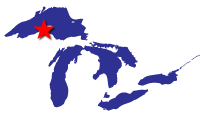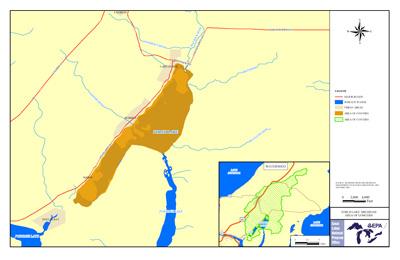Torch Lake AOC
Locate It
Contact Us
Heather Williams
(Williams.Heather@epa.gov)
312-886-5993
Latest News
- EPA awards $854,977 to Michigan for study of Upper Peninsula’s Torch Lake
- EPA announces projects to clean up contaminated sediment in two Great Lakes Areas of Concern
Overview
The Torch Lake Area of Concern (AOC) is one of the 31 U.S.-based AOCs across the Great Lakes designated under the 1987 Great Lakes Water Quality Agreement. The boundary of the Torch Lake AOC includes Torch Lake and its immediate environs. Immediate environs are those areas along the shore of Torch Lake where wastes from the production of copper contributed directly to the contaminant loadings of Torch Lake.
Mining of the native copper found in the region's bedrock formations began during the 1840s and continued until 1968, when all mining related operations ceased. Waste products from industrial milling, smelting and leaching operations of the mined ore are the main source of pollution in Torch Lake. In addition to copper, other contaminants of concern in the AOC are heavy metals, PCBs and polycyclic aromatic hydrocarbons (PAHs).
Beneficial Use Impairments
An interim success of remediation and restoration work is removing Beneficial Use Impairments (BUIs). BUIs are designations given by the International Joint Commission, representing different types of significant environmental degradation. BUIs are removed when sufficient environmental health improvements have been demonstrated through monitoring. The list below shows which BUIs have been removed, and which remain. Once all BUIs are removed, the process of delisting the AOC can begin.
- Restrictions on Fish and Wildlife Consumption
- Degradation of Benthos
- Fish Tumors or Other Deformities – Removed 2007
- General information about BUIs: Beneficial Use Impairments for the Great Lakes AOCs
Remediation and Restoration Work
EPA has continually worked with federal, state and local partners to execute remediation and restoration work with the ultimate goal of removing the AOC designation. Evolving projects aimed at improving the environmental health of Torch Lake include the Torch Lake GLLA Focused Feasibility Study and the Torch Lake Degradation of Benthos BUI benthos pilot study project.
The Torch Lake Degradation of Benthos BUI project is a benthos pilot study funded by the Great Lakes Restoration Initiative (GLRI). The developing plan will include construction of a series of pilot-scale shoreline capping and habitat restoration test plots. It will determine the potential to improve the density and diversity of the Torch Lake benthic community.
Torch Lake GLLA Focused Feasibility Study
On August 20, 2019, EPA signed a Great Lakes Legacy Act (GLLA) Project Agreement with Honeywell International, Inc. to perform a Focused Feasibility Study (FFS) at the Torch Lake Area of Concern. This is the first GLLA Project Agreement signed at the Torch Lake AOC. The FFS will be performed in two areas of Torch Lake, the Lake Linden Recreational Area (LLRA) and the Hubbell Processing Area (HPA).
The FFS will focus on developing remedial alternatives for addressing PCB, lead and arsenic contaminated sediment in both areas, as well as mining waste abandoned in the lakebed in the Hubbell Processing Area. Addressing contaminated sediment in these two areas will contribute to removing the Restrictions on Fish and Wildlife Consumption BUI.
In addition to performing the FFS, the Project Agreement includes removal of hazardous piles along Torch Lake for source control. Source control work, conducted by Honeywell, was completed in fall 2019. Additional sampling required for the FFS will take place in summer of 2020.
Partners
The following links exit the site Exit
- Michigan Department of Environment, Great Lakes, and Energy
- Michigan Department of Natural Resources
- Michigan Technical University
- Torch Lake Public Advisory Council
- Michigan Sea Grant


